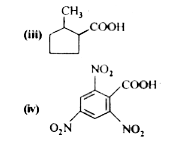Out of the following salts:
i. NaH2BO3 ii. NH2CH2COOH
iii. CH3COONH4 iv. NaHS
Salts (i) has concentration-depends pH.
The correct Answer is:A
To determine whether the statement "Salts (i) has concentration-depends pH" is true or false, we will analyze the given salts one by one, focusing on the first salt, NaH2BO3.
1. Identify the Nature of the Salt:
- The first salt is NaH2BO3, which is the sodium salt of boric acid (H3BO3).
- It is formed from a strong base (NaOH) and a weak acid (H3BO3).
2. Understand the pH Dependence:
- When a salt is derived from a strong base and a weak acid, it can hydrolyze in water. This hydrolysis affects the pH of the solution.
- The hydrolysis of NaH2BO3 can be represented as:
\(
NaH_2BO_3 \rightarrow Na^+ + H_2BO_3^-
\)
- The H2BO3− ion can further react with water:
\(
H_2BO_3^- + H_2O \rightleftharpoons H_3BO_3 + OH^-
\)
- This reaction produces hydroxide ions (OH^-), which increases the pH of the solution.
3. Expression for pH:
- The pH of a solution containing a salt that hydrolyzes can be expressed using the formula:
\(
pH = 14 + pK_a + \log C
\)
- Here, \(C\) is the concentration of the salt, and \(pK_a\) is the dissociation constant of the weak acid (in this case, boric acid).
4. Conclusion:
- From the formula, it is clear that the pH of the solution depends on the concentration of the salt (C). Therefore, the statement that "salts (i) has concentration-depends pH" is True.
Final Answer:
The statement is True.
- The first salt is NaH2BO3, which is the sodium salt of boric acid (H3BO3).
- It is formed from a strong base (NaOH) and a weak acid (H3BO3).
- When a salt is derived from a strong base and a weak acid, it can hydrolyze in water. This hydrolysis affects the pH of the solution.
- The hydrolysis of NaH2BO3 can be represented as:
\(
NaH_2BO_3 \rightarrow Na^+ + H_2BO_3^-
\)
- The H2BO3− ion can further react with water:
\(
H_2BO_3^- + H_2O \rightleftharpoons H_3BO_3 + OH^-
\)
- This reaction produces hydroxide ions (OH^-), which increases the pH of the solution.
- The pH of a solution containing a salt that hydrolyzes can be expressed using the formula:
\(
pH = 14 + pK_a + \log C
\)
- Here, \(C\) is the concentration of the salt, and \(pK_a\) is the dissociation constant of the weak acid (in this case, boric acid).
- From the formula, it is clear that the pH of the solution depends on the concentration of the salt (C). Therefore, the statement that "salts (i) has concentration-depends pH" is True.
The statement is True.
Topper's Solved these Questions
- IONIC EQUILIBRIUMBOOK - CENGAGE CHEMISTRY ENGLISHCHAPTER - IONIC EQUILIBRIUMEXERCISE - Archives Multiple Correct
3 Videos
- IONIC EQUILIBRIUMBOOK - CENGAGE CHEMISTRY ENGLISHCHAPTER - IONIC EQUILIBRIUMEXERCISE - Archives Single Correct
25 Videos
- IONIC EQUILIBRIUMBOOK - CENGAGE CHEMISTRY ENGLISHCHAPTER - IONIC EQUILIBRIUMEXERCISE - Exercises Integer
10 Videos
- HYDROGEN, WATER AND HYDROGEN PEROXIDEBOOK - CENGAGE CHEMISTRY ENGLISHCHAPTER - HYDROGEN, WATER AND HYDROGEN PEROXIDEEXERCISE - Subjective Archive (Subjective)
3 Videos
- ISOMERISMBOOK - CENGAGE CHEMISTRY ENGLISHCHAPTER - ISOMERISMEXERCISE - Assertion-Reasoning Type
1 Videos
Similar Questions
Knowledge Check
The order of decreasing stability of the following carbanions is
(i) (CH3)3C−
(ii) (CH3)2CH−
(iii) CH3CH−2
(iv) C6H5CH−2A(i)gt(ii)gt(iii)gt(iv)B(iv)gt(iii)gt(ii)gt(i)C(iv)gt(i)gt(ii)gt(iii)D(iii)gt(ii)gt(i)gt(Iv)
Identify the electrophile center in the following :
(i) CH3CHO (ii) CH3CH=CH2 (iii) CH3COCH3
View SolutionFind the the valency factor for following acids
(i)CH3COOH (ii)NaH2PO4 (iii)H3BO3
View SolutionThe correct order of Ka is :
(i) CH3−CH2−COOH
(ii) OHC−CH2−COOH
(iii) Ph−CH2−COOH
View SolutionWhich out of the following does not react with acetyl chloride? (i)CH3NH2(ii)(CH3)2NH(iii)(CH3)3N
View SolutionGive the decreasing order of reactivity of the following alkyl halides in the Williamson's reaction.
i. (CH3)3C−CH2Br ii. CICH2CH=CH2
iii. (CICH2CH2CH3 iv. BrCH2CH2CH3
View SolutionThe gases produced in the following reactions are respectively
I:CH3NH2+NH2Br→
II:CH3SO3H+NaHCO3→
III:CH3−C∣∣O−NH2+NaH→
View SolutionP4+NaOH→PH3↑+NaH2PO2
View Solution

